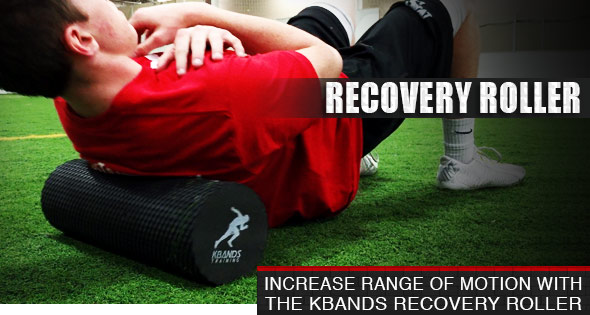Tricep Stretches | Recovery Foam Rolling Triceps
The triceps are a muscle in the back of the upper arm which aid in extending the arms. The muscles which make up the triceps are the medial, long, and lateral triceps brachii. The largest of these three muscles is the long triceps brachii, which runs from behind the elbow and attaches near the shoulder blade. This muscle is important to perform overhead movements, such as an overhead tricep extension.
All three of the muscles which make up the triceps work together to help stabilize the arm, extend the forearm, or aid the chest and shoulders in fully extending the arms (as in a bench press/overhead press). Triceps stretches must be performed with all upper body workouts. If these muscles are not functioning at full capacity athletes can see limitations in shoulder mobility and strength.
Limits in shoulder mobility and strength can be detrimental to a baseball players throwing motion, just as it can impede or alter a basketball players shot. Remember the triceps are responsible for aiding in any movement which extends the hands away from the body. All movements which perform this function, whether sports or training related movements, will utilize the triceps. Therefore, care must be given when performing triceps stretches so that all three heads of the triceps are prepared for physical activity.
How Tricep Stretches Aid Other Muscles
Completing a movement in all lifts there are different muscles of different sizes working in different capacities. While performing pressing lifts the muscles of the triceps are responsible for aiding larger muscles in continuing to extend the hand away from the body. The triceps aid the shoulders in fully extending the hands away from the body during overhead presses, just as the triceps aid the chest in fully extending the arms during a bench press. During the bench press the chest would be considered the agonist (prime mover) as the muscles of the triceps would be acting as a synergist (aiding in movement).
The importance of synergists, such as the triceps in the body, cannot be overstated. Our arms could not straighten out all the way and achieve a full range of motion without synergistic muscles like the triceps. The entire body works as a single unit. This is why Recovery Foam Rolling triceps is so important for athletic performance. Any discomfort or limitations of the triceps places serious stress and restriction on many other large muscles of the upper body.
Recovery Foam Rolling Triceps
Tricep stretches are a simple and effective way for athletes to avoid injuries in the upper body. Athletes will increase the force produced by other large muscles of the upper body decreasing injuries and tightness by taking care to stretch the entire group of muscles which make up the triceps. When Recovery Foam Rolling the triceps it is important that all three heads (long, medial, and lateral) are worked during the tricep stretches.
Athletes will begin the tricep stretches by lying on the ground on their back with the Recovery Foam Roller lying parallel to their body. Athletes will begin the tricep stretch by extending the arm completely straight and placing the back section of the upper arm on the Recovery Foam Roller. Athletes should keep the body parallel to the Recovery Foam Roller throughout the entire tricep stretch, tilting slightly to reach different trigger points while massaging the muscles. Athletes will begin just above the elbow, apply pressure and roll until just below the armpit. This motion will allow for the entire length of the muscle to be worked during the tricep stretches. If discomfort is felt a static hold of 20-30 seconds should be held followed by 1-3 inch massaging rolls over the trouble area. This process should be continued all the way down and back up the arm. Athletes performing the tricep stretches should actively be searching for discomfort in the muscles of the triceps.
Part of the searching process involves slightly rotating the arm during the tricep stretches. Beginning with the arm straight, athletes should perform the first 1-2 rolls with their thumb pointed in the air. Next athletes should perform the tricep stretch with their palm down followed by foam rolling with the palm facing up. Pressure should be continually applied as athletes move up and down the back of the arm from the three different hand positions. By rotating the hand during the tricep stretch athletes will be able to hit all three heads of the tricep with the Recovery Foam Roller. Athletes decrease the likelihood of an injury while preparing the arms for physical activity by properly preparing all muscles of the triceps.
Once athletes have mastered the rolling technique of the tricep stretch they can move onto a more advanced tricep stretch with the Recovery Foam Roller. Keeping the same body positioning, athletes should begin to roll the Recovery Foam Roller down the arm flex the bicep slightly raising the hand in a fist. As athletes flex the bicep they should focus on pressing the back of the arm into the Recover Foam Roller. This is an excellent technique for stretching and increasing blood flow to the muscles of the triceps.
Tricep Stretches For The Rest Of The Body
Even though triceps are not the biggest muscle in the body they play a major role in aiding larger muscles of the body to complete pressing movements or movements involving extension of the arm. To help the triceps function at a high level the other muscles of the body must be prepared as well. The shoulders and chest are the two major muscles aided by the triceps. Tricep stretches, along with stretches for the chest and shoulder, will help prepare the body for any athletic activity involving a large amount of upper body pushing, pulling, or quick extension of the arms.

